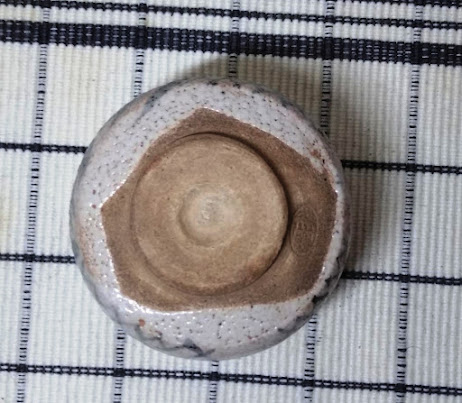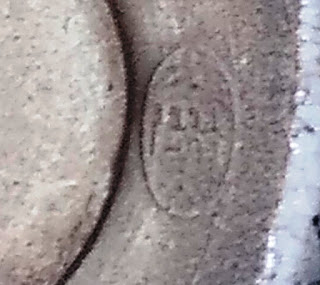215. E-Shino 画志野 (painted Shino) chawan (teabowl)
Light tan clay, with black underpainting on the walls and a thin coating of Shino glaze on all but the foot ring and the area of the base around it. Weight 196 g (7 oz). Height: 7 cm (2-3/4 in). Diameter: rim, 8.2 cm (3-5/16 in); maximum: 9.3 cm (3-5/8 in); of foot ring: 4.5 cm (1-3/4 in).
This sits on the flat foot ring which is about 0.5 cm (3/16 in) high on the outer rim and about half that in the center. The symmetry of the ring foot and the inner depression suggest that they were formed on a wheel. Above the foot, the base rises outward and upward at a shallow angle to a height of 1.2 cm (1/2 in). The kiln or the artist’s seal, an oval cartouche, was impressed into the base beside the foot ring. There are two characters written in seal script, but the impression is so light that they cannot be read. The walls are roughly vertical, rising for about 6 cm (2-1/4 in). There is a horizontal groove about three-quarters of way up the walls, roughly a finger’s depth. Below and above this groove, the walls bow outward slightly in shallow arcs. The maximum diameter is 2.7 cm (1-1/8 in) above the base. The front of the cup has a swooping design of two rough semicircles with a curved stem rising above them in the center and a fillip on either side. Within each semicircle is a cross-hatch pattern. On either side of this design is a series of short crossed lines, reminiscent of those used in Japanese drawings to indicate fences. The back of the cup has another series of these short crossed lines. The surface of this is lightly pitted.
This came with a box. The box is uninscribed, but a sheet of paper attached to one side has 志野茶盃 (Shino teacup) written on it. To the right of this is a small line of faint characters; the second character appears to be a variant form of the word for “kiln” 焼; the third looks like 家 (“family”).
The underpainting was done in a black glaze. A thin layer of Shino glaze was applied over this on all but the foot ring and the surrounding area of the base. The Shino has a slightly pinkish glaze, more on the inside than on the outer walls.
The seller claims that this is a Meiji (1868-1912) era piece. It is a good example of an e-shino piece. The underdrawing was executed with free-flowing ease and spirit.
Purchased from Treasures of Old Times in Bangkok, Thailand, May 2023.












No comments:
Post a Comment